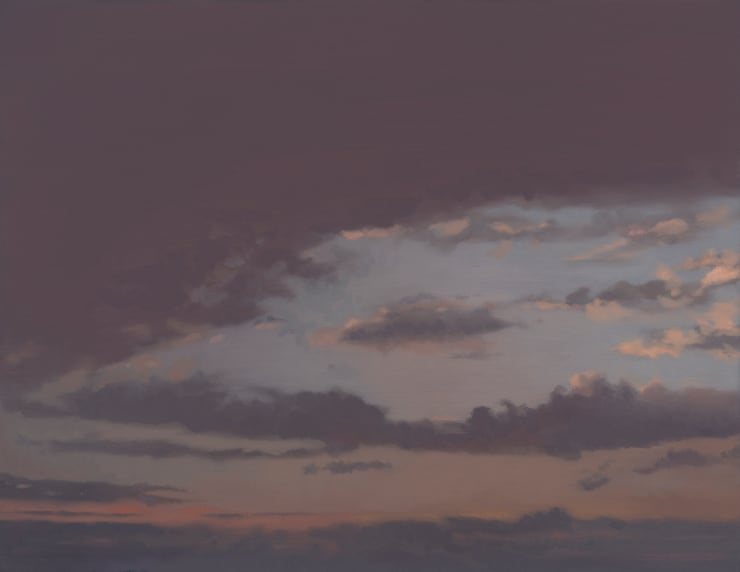Tõnis Saadoja Estonian, b. 1980
For his first exhibition at Pontone Gallery, Estonian artist Tõnis Saadoja documents his response to personally-significant source material in two discrete sets of paintings: small pictures of skies and larger ones of architecture. He deploys a different technique for each. The skies are rendered with a full-colour palette in a naturalistic mode of representation, while the architectural subjects are graphically described in a minimal range of muted hues which emphasises flatness and a sense of cool detachment.
Saadoja follows a systematic programme to develop each of his themes. The paintings are worked on in series, images are variations of the same closely-related motifs, technique is consistent and unvarying. He uses a controlled model of expression where no brushstroke is out of place or ambiguous. The rendering is entirely descriptive and not speculative, colour values are definite and operate within tight tonal ranges. There is no overtly gestural handling that would subvert an effective representational description of the subject. Saadoja makes it very clear that his picture-making process is cerebral and deliberate.
The artist proposes a particular idea of the Nordic sky, one that for an Estonian is desired, but only available in summer. In the autumn and winter months it is dark and only experienced as a memory or 'dream of the future'. His images fit within a Western convention of landscape painting, which he has so skilfully emulated, but are distinct from it.
The architectural studies are articulated in the impassive language of technical illustration and are seen as if through a mist. They are remote, ideal and utopian. There is a feeling of emptiness and absence of substance, despite the implicit solidity of such subject matter. This is counterbalanced, however, by the subtlety and nuance of the picture-making which evokes a romantic atmosphere, an echo of lost summer skies.
-
 Evening Sky I, 2024Oil on canvas35 x 45 cm
Evening Sky I, 2024Oil on canvas35 x 45 cm
13.8 x 17.7 in -
 Evening Sky II, 2024Oil on canvas35 x 45 cm
Evening Sky II, 2024Oil on canvas35 x 45 cm
13.8 x 17.7 in -
 Evening Sky III, 2024Oil on canvas35 x 45 cm
Evening Sky III, 2024Oil on canvas35 x 45 cm
13.8 x 17.7 in -
 Variations on the Summer Sky I, 2024Oil on canvas28 x 43 cm
Variations on the Summer Sky I, 2024Oil on canvas28 x 43 cm
11 x 17 in -
 Variations on the Summer Sky II, 2024Oil on canvas30 x 40 cm
Variations on the Summer Sky II, 2024Oil on canvas30 x 40 cm
11.8 x 15.7 in -
 Painting of Norrby Lower Lighthouse (After Photo by Helene Fendt), 2023Oil on canvas248 x 176 cm
Painting of Norrby Lower Lighthouse (After Photo by Helene Fendt), 2023Oil on canvas248 x 176 cm
97.6 x 69.3 in -
 March. Pale Purple, 2022Oil on canvas195 x 150 cm
March. Pale Purple, 2022Oil on canvas195 x 150 cm
76.7 x 59 in -
 October. Silver Grey, 2021Oil on canvas195 x 150 cm
October. Silver Grey, 2021Oil on canvas195 x 150 cm
76.7 x 59 in
Send me more information on Tõnis Saadoja
-

The Glow of Life
A Group Exhibition 6 Mar - 5 Apr 2025The Glow of Life brings together the work of Lee Jeonglok, Timothy Spall, Jarek Puzcel, and Tonis Saadoja—four artists who explore the interaction between natural and artificial light across land, sea, and sky.Read more -

Lost Summer Skies
Kristi Kongi & Tõnis Saadoja 3 May - 6 Jul 2024Kristi Kongi makes paintings and site-specific installations. Her work is rooted in a formal exploration of light, colour and space, initiated by her memories and experiences of significant landscapes and...Read more










